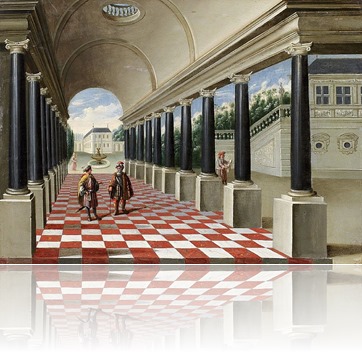I have talked about memory and memorization before, but not about the Memory Palace. What brought it to mind was this passage from Book X of St. Augustine’s Confessions:
And I come to the fields and spacious palaces of my memory, where are the treasures of innumerable images, brought into it from things of all sorts perceived by the senses.
While St. Augustine is waxing eloquent about the beauty and power of memory, he drops this line which contains a relatively inconspicuous idea that is incredibly profound: the Memory Palace.
Several writers have explored the concept of the Memory Palace, how and why to build one, but let me simply just get at what it is: A Memory Palace is an imaginary building you can make in order to store information. Think of it as a mental hard drive from the Middle Ages. Hard drives have sectors where information is stored in chunks, all the way down to bits and bytes. Similarly, human beings can only store information by breaking it down into pieces and filing it away in our minds.
Unfortunately, most of us were never taught how to memorize, we were just given a pile of information and told to memorize it. Memorizing without any technique is what we call “rote” memorization, where a person simply repeats and repeats the information until it sticks. Because rote memorization is so difficult and seemingly fruitless—most of us lose whatever we had memorized in a couple days—a lot of schools have simply given up on memorization altogether. But this is a mistake.
The ancients and medievals had to memorize loads of information because few knew how to read and write proficiently and of those who did, writing utensils and parchment were expensive and hard to come by (kind of like how a pack of sticky notes will cost you ten bucks now, only worse!). So, these people had to compensate with the only computer on hand: the brain. But they weren’t lazy about it. They didn’t just throw their heads at information and hope that the two would stick together. No. They developed battle-hardened techniques over a long period of time. The essential technique is the Memory Palace.
It starts with associating an idea with a physical object like a door, or a chair. One then can “walk” through say, your own house or apartment and stow pieces of information “in” different objects. There are two themes to the technique. One is the word-object association, the other is proceeding through the palace in a certain order.
For example, imagine you had been asked to give a speech on the classification of living creatures. If your house has five rooms, you could put each the five kingdoms in a separate room (Bacteria, Protozoa, Plants, Fungi, Animals) and then each piece of furniture in the room could represent the phyla within that kingdom. As you proceed through this Memory Palace, you could recall each of the phyla of all five kingdoms as you give your speech. In fact, the Memory Palace was the origin of speakers saying “in the first place…” and “in the second place…” The “places” they refer to are the rooms within their memory palace.
I have found it to be a very helpful memorization technique, especially when paired with the link system and other memorization aids (e.g., making exaggerated and silly word-pictures). As our generation copes with information overload (deluge, tidal wave), we have to find ways to remember the information that is important to us, the information we need to use, connect and synthesize, not the trivia we can look up. If we want to avoid becoming Google Glass fixated cell phone addicts who can’t hold a coherent conversation because we’re so distracted with looking things up online, we might need to recover the Memory Palace that St. Augustine stood in awe of and thanked God for saying, “Great is the power of memory; very wonderful is it, O my God.”

